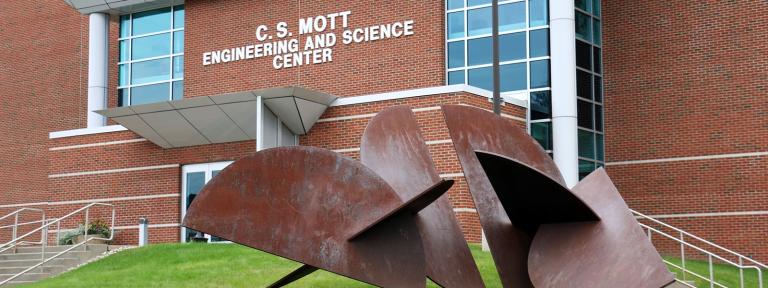
When Seth Lerner went looking for a way to join the Kettering Formula SAE team he didn't know he would find his graduate thesis waiting for him. Lerner, of Rochester, N.Y., approached Formula team faculty adviser Dr. Craig Hoff about joining the team during his tenure as a graduate student in Automotive Systems at Kettering.
"I had participated in Formula at the University of Pittsburgh where I received my undergraduate degree," said Lerner, "and I wanted to get involved at Kettering." Hoff saw not only a new team member but a potential graduate assistant as well.
"Seth was in the right place at the right time and wound up with a hybrid position," said Hoff, associate professor of Mechanical Engineering. "Half of his support is coming from the Research Office, to work on the fuel cell project, and half is coming from the Mechanical Engineering department, to work with the Formula team."
Lerner first spent a term reconditioning an existing fuel cell project from a former graduate student. He found out that what he calls "Version One" had leaks, "so it was not good for producing test data," said Lerner.
"The previous test bench was functional," he said, "but I wasn't satisfied with its performance. My idea was to rebuild it to get more repeatable data." A test bench includes a fuel cell stack and the 'balance of plant' - or mechanical system that makes the fuel cell produce energy.
The stack converts chemical energy to electrical energy and is literally a stack of layered graphite plates with a thin layer of membrane similar to Teflon between each plate. The membrane keeps the positive and negative sides of the charge separate inside the stack.
Lerner has spent the last year and half building a new test bench around a new fuel cell stack donated by Anuvu, a producer of patented hydrogen fuel cell stacks and competitive energy systems for OEMs, governments, private research and development laboratories and academic institutions. "Now we can start the fun stuff," said Lerner, of the testing phase.
The testing phase will characterize the fuel cell's output based on various input parameters. "Primarily, the bench will allow for the characterization of the output of electrical energy in kilowatt power based on what we feed it," said Lerner.
"Feeding" the fuel cell involves hydrogen introduced at the right pressure while taking into consideration the gas humidity levels and temperature of the stack itself, all factors that affect efficient performance. "We're not so interested in the internals," said Lerner, "we can't change the basic characteristics. We're approaching it more from an applications engineering standpoint - what can it do for us?
"We are going to try and characterize the fuel cell's performance and then size it to a practical application," he continued. "Dr. Hoff thought it might be able to be used as a range extender for a handicapped vehicle like an Amigo," he added, "but prior to doing something like that we have to know how the fuel cell performs under different conditions. And, we'll have to develop a control algorithm to recharge the battery."
"The immediate goal of the project was to develop the test bench that could be used to evaluate the fuel cell stack. The resulting test stand could also be used to support fuel cell education at Kettering," said Hoff. Fuel cell education was the incentive for Anuvu to donate the current stack, he added, saying the company's support also includes Anuvu CEO Rex Hodge joining the Kettering Fuel Cell Integration Center Advisory Board.
After Lerner characterizes the fuel cell's performance, Hoff said the next step will be to try and package it into a portable unit. "Once this conversion is accomplished we would be able to power something like the Amigo,"Hoff said. The last phase of the project will be to work with Anuvu to develop a fuel cell that could be used to power a GM EV1 car.
The fuel cell Lerner built is rated at 1.5 kilowatt power, meaning "it might be able to power a standard hair dryer, weed whacker or 15 100-watt light bulbs," Lerner said. "Building this system has given us all a real appreciation for the stand-alone fuel cells we buy," said Hoff. Stand-alone fuel cells are functioning fuel cell systems manufactured professionally and capable of generating controlled power - unlike the system Lerner built from scratch with a pre-made stack.
But building it from scratch has given Lerner and Hoff greater insight into fuel cells. "What we're doing involves the same basic principles that auto manufacturers use developing and producing hybrid and fuel cell vehicles," said Hoff.
The automakers, in turn, recognize the value of students with experience building fuel cells. A previous Kettering graduate assistant was hired by General Motors Advanced Powertrain division to work on their hybrid vehicle.
Lerner will be prepared for the marketplace in June, after earning a master's of Mechanical Engineering in Automotive Systems. He sees his work on the fuel cell as highly relevant to his degree program. "Working with fuel cells pertains to automotive systems because it pertains to powertrain development," he said, "whether it's charging the battery to run the motor or directly running the motor itself."
As long as it's working with engines "I'll be happy," said Lerner. He may postpone entering the "real" world for a little while, however. "I would like to go for my Ph.D.," he said. Maybe being the Formula team FACULTY adviser at a university is part of his future.
Written by Dawn Hibbard
810-762-9865
dhibbard@kettering.edu